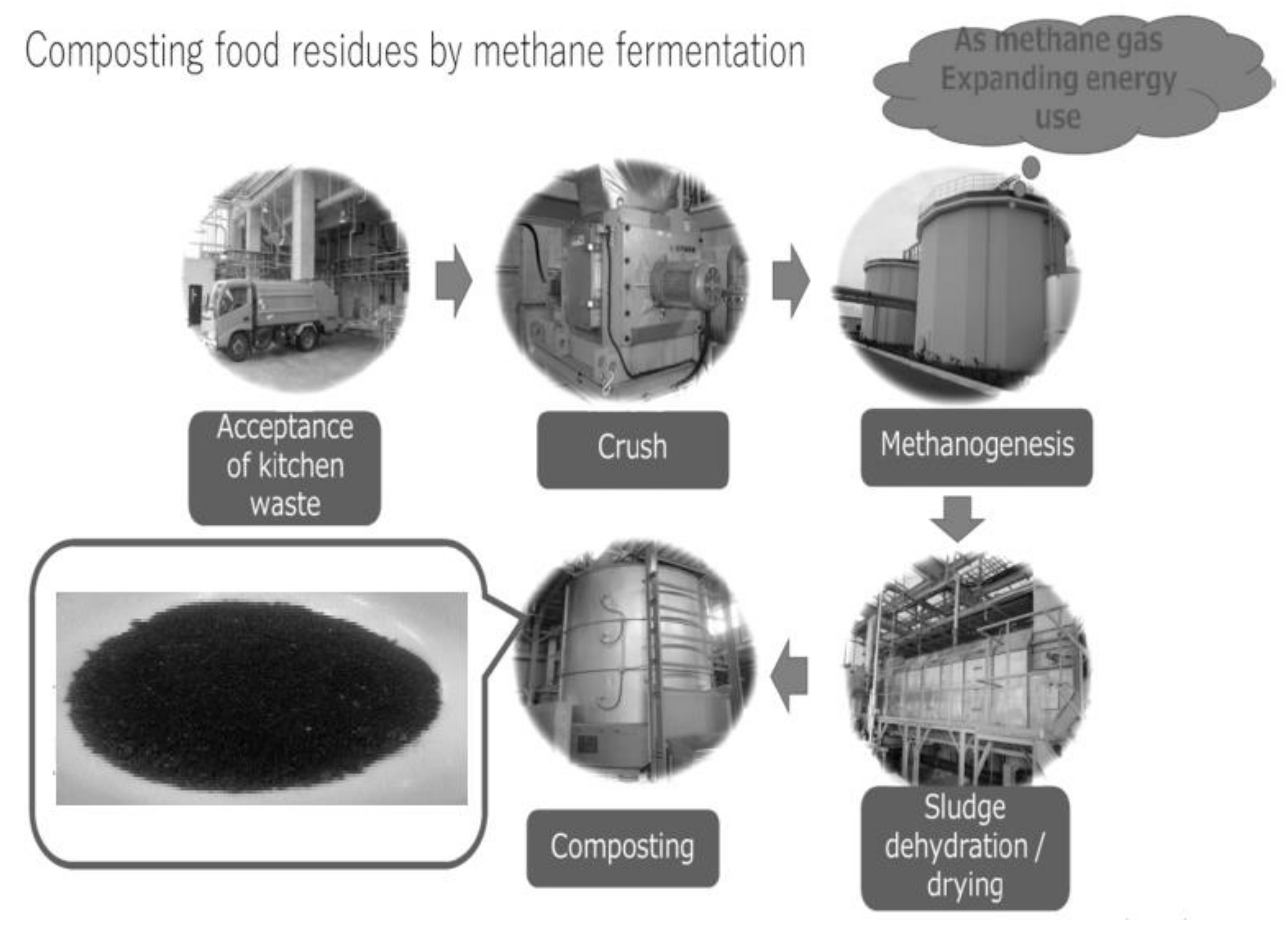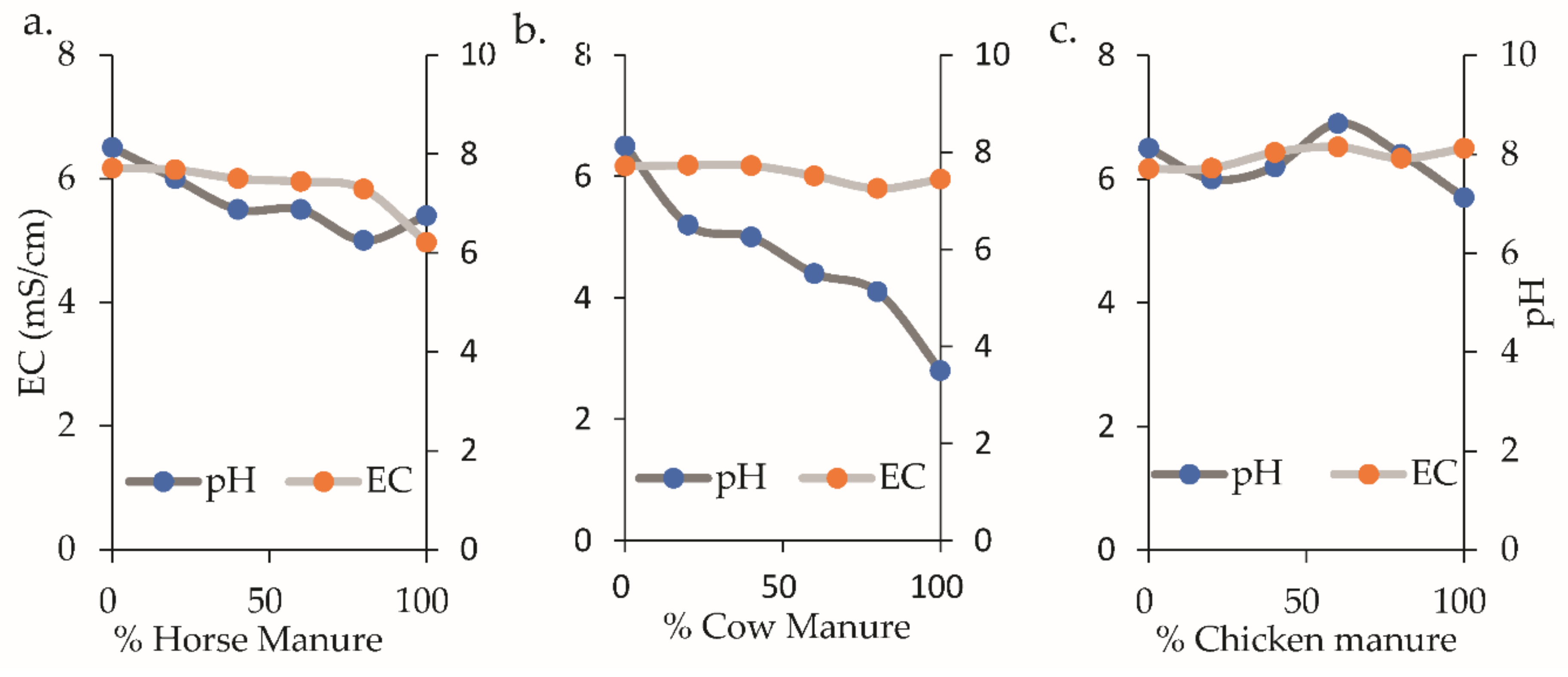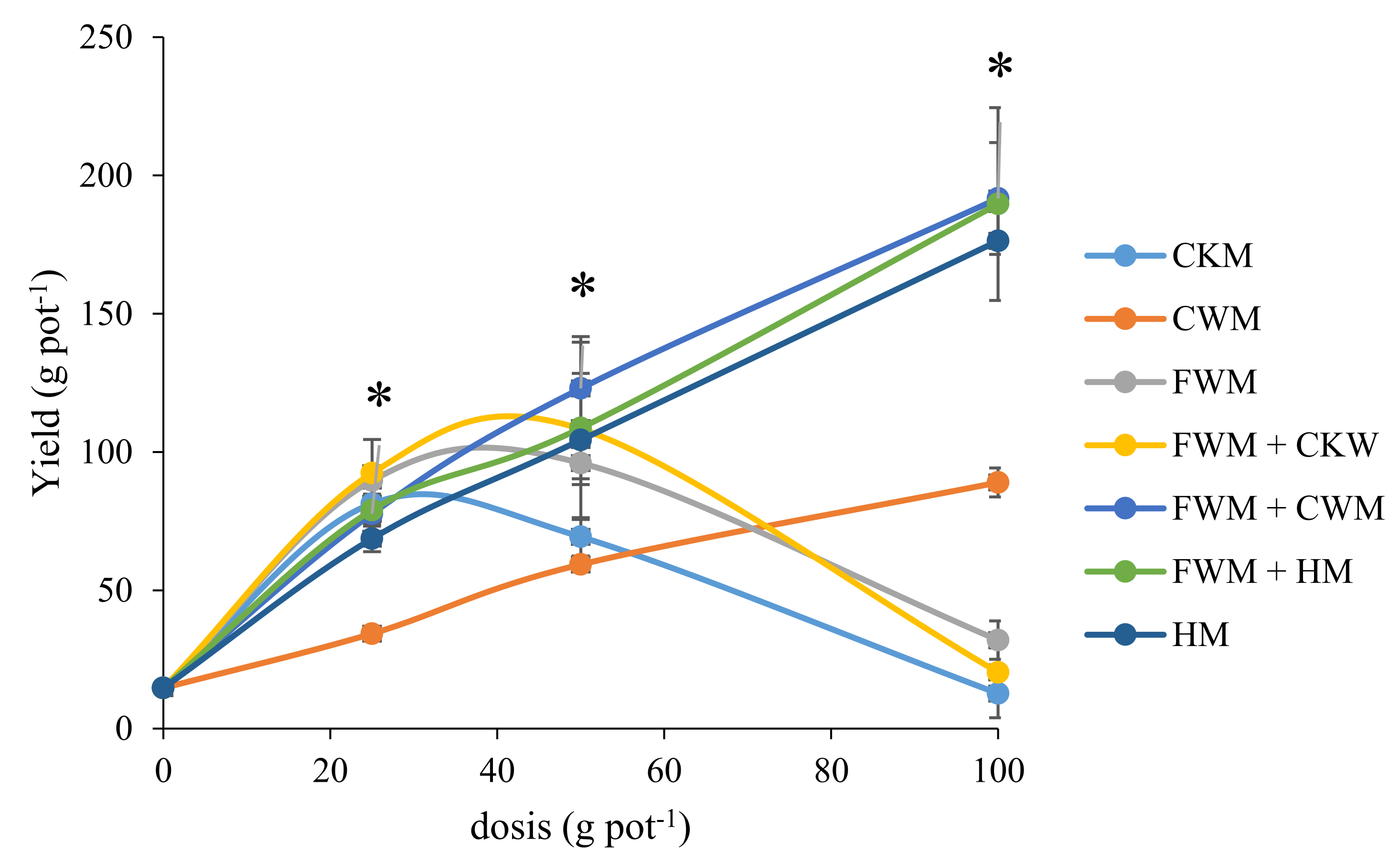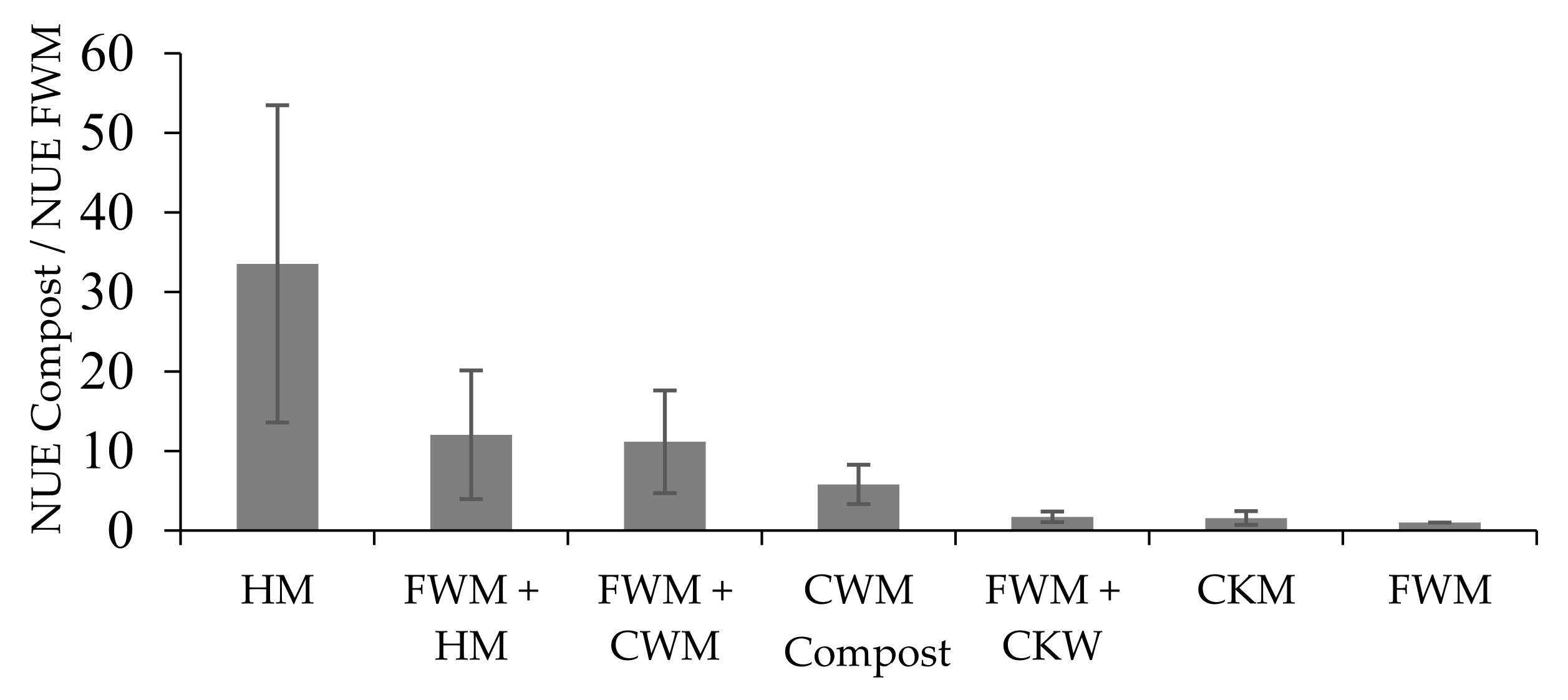Methane Fermentation Residue Compost Derived from Food Waste to Aid Komatsuna (Brassica rapa) Growth
Abstract
:1. Introduction
2. Materials and Methods
2.1. Site Description and Experimental Design
2.2. Compost Material and Procedure
2.3. Evaluation of FWM Characteristics on Komatsuna Germination
2.4. FWM Improvement for Komatsuna Production
2.4.1. Komatsuna Cultivation Test
2.4.2. Carbon and Nitrogen Analysis of Komatsuna
2.4.3. Data Analysis
3. Results
3.1. Evaluation of FWM Characteristics on Komatsuna Germination
3.1.1. pH and EC in the Combination of FWM and Animal Manure
3.1.2. The Germination, Radicle Length, and Germination Index of KOMATSUNA
3.2. FWM Improvement for Komatsuna Production
3.2.1. Komatsuna Yield
3.2.2. Total Carbon and Nitrogen of Komatsuna
3.2.3. Nitrogen Uptake of Komatsuna
3.2.4. Nitrogen Use Efficiency (NUE) of Komatsuna
4. Discussion
4.1. Evaluation of FWM Characteristics on Komatsuna Germination
4.2. FWM Improvement for Komatsuna Production
5. Conclusions
Author Contributions
Funding
Institutional Review Board Statement
Informed Consent Statement
Data Availability Statement
Acknowledgments
Conflicts of Interest
References
- Fred, M.; Harold, V.E. Building Soil for Better Crops Sustainable Soil Management. In The Sustainable Agriculture Research and Education (SARE) Program, with Funding from the National Institute of Food and Agriculture, U.S. Department of Agriculture, 3rd ed.; University of Maryland: College Park, MD, USA; University of Vermont: Burlington, VT, USA, 2009; pp. 3–294. [Google Scholar]
- Gustavsson, J.; Cederberg, C.; Sonesson, U.; Otterdijk, V.R. Global Food Losses and Food Waste; Extent, Causes and Prevention; Swedish Institute for Food and Biotechnology (SIK) and Food and Agriculture Organization of the United Nations: Gothenburg, Sweden; Rome, Italy, 2011. [Google Scholar]
- Rockström, J.; Steffen, W.; Noone, K.; Persson, A.; Chapin, S.F.; Lambin, E.F.; Lenton, T.M.; Scheffer, M.; Folke, C.; Hans, P.K.; et al. A safe operating space for humanity. Nature 2009, 461, 447. Available online: http://tinyurl.com/boundariesblog (accessed on 27 September 2021). [CrossRef] [PubMed]
- OjikutuAbimbola, O.; Osokoya, O. Evaluation of biogas production from food waste. Int. J. Eng. Sci. (IJES) 2014, 3, 1–7. [Google Scholar]
- Oliveira, F.; Doelle, K. Anaerobic digestion of food waste to produce biogas: A comparison of bioreaction to increase methane content. J. Food Process Technol. 2015, 6, 2157–7110. [Google Scholar] [CrossRef]
- Levis, J.W.; Morton, A.B. What is the most environmentally beneficial way to treat commercial food waste? Environ. Sci. Technol. 2011, 45, 7438–7444. [Google Scholar] [CrossRef] [PubMed]
- Ismail, M.M. Appropriate Compost Management Using for Fallen Leaves and Methane Fermentation Residues. Master’s Thesis, Universitas Ibaraki, Ami City, Ibaraki Prefecture, Japan, September 2017. [Google Scholar]
- Bernal, M.P.; Alburquerque, J.A.; Moral, R. Composting of animal manures and chemical criteria for compost maturity assessment. Bioresour. Technol. 2009, 100, 5444–5453. [Google Scholar] [CrossRef] [PubMed]
- Komilis, D.; Kanellos, D.A. Modified dynamic respiration test to assess compost stability: Effect of sample size and air flowrate. Bioresour. Technol. 2012, 117, 300–309. [Google Scholar] [CrossRef] [PubMed]
- Luo, Y.; Liang, J.; Zeng, G.; Chen, M.; Mo, D.; Li, G.; Zhang, D. Seed germination test for toxicity evaluation of compost: Its roles, problems and prospects. Waste Manag. 2018, 71, 109–114. [Google Scholar] [CrossRef] [PubMed]
- Zucconi, F.; Monaco, A.; Debertoldi, M. Biological evaluation of compost maturity. Biocycle 1981, 22, 27–29. [Google Scholar]
- Cesaro, A.; Belgiorno, V.; Guida, M. Compost from organic solid waste: Quality assessment and Europeanregulations for its sustainable use. Resour. Conserv. Recycl. 2015, 94, 72–79. [Google Scholar] [CrossRef]
- Hase, T.; Kawamura, K. Evaluating compost maturity with a newly proposed index based on a germination test using Komatsuna (Brassica rapa Var. Peruviridis) seeds. J. Mater. Cycles Waste Manag. 2012, 14, 220–227. [Google Scholar] [CrossRef]
- Bewley, J.D. Seed germination and dormancy. Sci. Hortic. 2019, 82, 415–420. [Google Scholar] [CrossRef] [PubMed] [Green Version]
- dan La Sarido, A. Uji empat jenis pupuk kandang terhadap pertumbuhan dan hasil tanaman cabai keriting (Capsicum annum L.). J. Agrifor 2013, 12, 22–29. [Google Scholar]
- Barbara, J.B. Nutrient deficiency symptoms. Mercer City. Hortic. 2010, 10, 1–8. [Google Scholar]




| Compost | N (%) | P (%) | K (%) |
|---|---|---|---|
| Cow Manure (CWM) | 1 | 1.4 | 1.5 |
| Horse Manure (HM) | 1 | 1.8 | 2 |
| Chicken Manure (CKM) | 2.3 | 2.5 | 3.4 |
| Food Waste Manure (FWM) | 5.66 | 1.92 | 0.52 |
| Compost | Ratio (FWM: HM/CKM/CWM) | Germination (%) | Radicle-Length (cm) | Germination Index (GI) |
|---|---|---|---|---|
| Methane-fermented food waste residue compost and horse manure | ||||
| FWM + HM | 0:5 | 97.3 ± 0.4 a | 19.7 ± 0.5 ab | 1.09 ± 0.05 a |
| FWM + HM | 1:4 | 92.0 ± 0.0 abc | 10.6 ± 0.4 c | 0.55 ± 0.04 c |
| FWM + HM | 2:3 | 94.0 ± 1.8 ab | 7.4 ± 0.7 cd | 0.40 ± 0.08 cd |
| FWM + HM | 3:2 | 72.0 ± 1.8 bcde | 4.7 ± 0.2 de | 0.19 ± 0.02 e |
| FWM + HM | 4:1 | 43.3 ± 4.4 f | 2.6 ± 0.1 e | 0.07 ± 0.02 e |
| FWM + HM | 5:0 | 18.0 ± 4.8 g | 2.8 ± 0.3 e | 0.03 ± 0.01 e |
| CT | 88.6 ± 1.5 abcd | 20.0 ± 0.5 a | 1.00 ± 0.00 ab | |
| Methane-fermented food waste residue compost and chicken manure | ||||
| FWM + CKM | 0:5 | 93.3 ± 2.1 ab | 9.1 ± 0.3 b | 0.35 ± 0.01 b |
| FWM + CKM | 1:4 | 76.7 ± 0.4 abc | 4.8 ± 0.1 c | 0.15 ± 0.01 c |
| FWM + CKM | 2:3 | 56.7 ± 6.0 d | 2.6 ± 0.2 c | 0.05 ± 0.02 d |
| FWM + CKM | 3:2 | 42.7 ± 2.3 de | 4.1 ± 0.0 c | 0.07 ± 0.00 d |
| FWM + CKM | 4:1 | 26.0 ± 1.3 e | 3.0 ± 0.1 c | 0.03 ± 0.00 d |
| FWM + CKM | 5:0 | 28.0 ± 1.8 e | 2.8 ± 0.1 c | 0.03 ± 0.00 d |
| CT | 95.3 ± 1.0 a | 25.3 ± 0.6 a | 1.00 ± 0.00 a | |
| Methane-fermented food waste residue compost and cow manure | ||||
| FWM + CWM | 0:5 | 92.7 ± 1.0 abc | 12.0 ± 0.3 c | 0.67 ± 0.11 abc |
| FWM + CWM | 1:4 | 94.7 ± 1.0 a | 19.1 ± 0.2 a | 1.07 ± 0.15 a |
| FWM + CWM | 2:3 | 92.0 ± 0.7 abcd | 8.0 ± 0.6 cd | 0.45 ± 0.13 cd |
| FWM + CWM | 3:2 | 84.7 ± 1.0 abcde | 5.8 ± 0.2 de | 0.30 ± 0.07 cd |
| FWM + CWM | 4:1 | 60.0 ± 1.3 f | 3.5 ± 0.2 de | 0.13 ± 0.04 d |
| FWM + CWM | 5:0 | 37.3 ± 2.8 g | 2.8 ± 0.1 e | 0.06 ± 0.01 d |
| CT | 94.7 ± 1.7 ab | 18.6 ± 1.5 ab | 1.00 ± 0.00 ab | |
| Treatment | Fresh Weight Yield (g pot−1) | Dry Weight Yield (g pot−1) | N Uptake (g pot−1) |
|---|---|---|---|
| Dose (g pot−1) | |||
| 100 | 90.79 ± 16.71 a | 5.57 ± 0.92 a | 18.43 ± 2.64 a |
| 50 | 85.46 ± 8.32 ab | 5.65 ± 0.42 a | 16.96 ± 1.63 ab |
| 25 | 67.21 ± 5.65 c | 5.56 ± 0.31 a | 11.03 ± 1.02 c |
| Compost | |||
| FWM + CWM | 130.78 ± 6.08 a | 7.46 ± 0.22 abc | 21.64 ± 4.01 a |
| FWM + HM | 125.78 ± 21.65 ab | 7.52 ± 1.15 ab | 20.71 ± 3.61 ab |
| FWM + CKM | 73.67 ± 15.35 d | 4.73 ± 0.90 d | 15.38 ± 2.33 c |
| CKM | 54.44 ± 11.10 defg | 3.17 ± 0.69 d | 13.98 ± 2.59 cd |
| HM | 116.44 ± 16.01 abc | 7.70 ± 0.72 a | 13.66 ± 2.33 cde |
| CWM | 60.89 ± 8.36 def | 4.87 ± 0.65 d | 7.00 ± 0.85 f |
| FWM | 72.56 ± 10.51 de | 4.87 ± 0.55 d | 4.46 ± 1.78 abg |
| CT | 14.67 ± 0.17 h | 2.13 ± 0.32 d | 2.79 ± 0.40 fh |
| Anova | |||
| Dose | * | ns | *** |
| Compost | *** | *** | *** |
| Dose × Compost | *** | *** | *** |
| Treatment | TC (%) | TN (%) |
|---|---|---|
| Dose (g pot−1) | ||
| 25 | 38.8 ± 0.2 a | 2.0 ± 0.2 c |
| 50 | 37.2 ± 0.4 b | 3.4 ± 0.4 b |
| 100 | 37.7 ± 0.3 b | 4.5 ± 0.5 a |
| Compost | ||
| CKM | 36.2 ± 0.7 e | 5.4 ± 0.6 a |
| FWM | 39.4 ± 0.3 ab | 4.8 ± 0.7 ab |
| FWM + CKM | 37.3 ± 0.4 cde | 4.2 ± 0.7 abc |
| FWM + HM | 37.7 ± 0.8 abcd | 3.1 ± 0.7 cd |
| FWM + CWM | 37.7 ± 0.4 cde | 2. 9 ± 0.5 cde |
| CT | 4.0 ± 0.1 a | 2 ± 0.2 def |
| HM | 38.2 ± 0.3 abcd | 1.7 ± 0.2 cd |
| CWM | 38.3 ± 0.3 abc | 1.4 ± 0.1 f |
| Anova | ||
| Dose | ** | *** |
| Compost | *** | *** |
| Dose × Compost | * | * |
| Treatment | NUE |
|---|---|
| Doses (g pot−1) | |
| 25 | 100.55 ± 11.82 a |
| 50 | 70.18 ± 11.40 b |
| 100 | 49.17 ± 12.14 c |
| Compost | |
| HM | 186.22 ± 10.73 a |
| CWM | 81.33 ± 4.39 b |
| FWM + CWM | 64.80 ± 4.93 bc |
| FWM + HM | 62.26 ± 7.87 bcd |
| CKM | 47.80 ± 17.92 cde |
| FWM + CKM | 42.32 ± 12.15 cde |
| FWM | 28.37 ± 7.32 e |
| Anova | |
| Doses | *** |
| Compost | *** |
| Doses × Compost | *** |
Publisher’s Note: MDPI stays neutral with regard to jurisdictional claims in published maps and institutional affiliations. |
© 2021 by the authors. Licensee MDPI, Basel, Switzerland. This article is an open access article distributed under the terms and conditions of the Creative Commons Attribution (CC BY) license (https://creativecommons.org/licenses/by/4.0/).
Share and Cite
Santi, N.; Dewi, R.K.; Suganuma, Y.; Iikubo, T.; Seki, H.; Komatsuzaki, M. Methane Fermentation Residue Compost Derived from Food Waste to Aid Komatsuna (Brassica rapa) Growth. Horticulturae 2021, 7, 551. https://doi.org/10.3390/horticulturae7120551
Santi N, Dewi RK, Suganuma Y, Iikubo T, Seki H, Komatsuzaki M. Methane Fermentation Residue Compost Derived from Food Waste to Aid Komatsuna (Brassica rapa) Growth. Horticulturae. 2021; 7(12):551. https://doi.org/10.3390/horticulturae7120551
Chicago/Turabian StyleSanti, Nur, Ratih Kemala Dewi, Yutaka Suganuma, Tsutomu Iikubo, Hiroichi Seki, and Masakazu Komatsuzaki. 2021. "Methane Fermentation Residue Compost Derived from Food Waste to Aid Komatsuna (Brassica rapa) Growth" Horticulturae 7, no. 12: 551. https://doi.org/10.3390/horticulturae7120551






